 W
WAtrypa is a genus of brachiopod with shells round to short egg-shaped, covered with many fine radial ridges, that split further out and growthlines perpendicular to the costae and 2-3 times wider spaced. The pedunculate valve is a little convex, but tends to level out or even become slightly concave toward the anterior margin. The brachial valve is highly convex. There is no interarea in either valve. Atrypa was a cosmopolitan and occurred from the late Lower Silurian (Telychian) to the early Upper Devonian (Frasnian). Other sources expand the range from the Late Ordovician to Carboniferous, approximately from 449 to 336 Ma. A proposed new species, A. harrisi, was found in the trilobite-rich Floresta Formation in Boyacá, Colombia.
 W
WChonetes is an extinct genus of brachiopods. It ranged from the Late Ordovician to the Middle Jurassic.
 W
WCincinnetina is an extinct genus of brachiopods which existed in what is now the United States during the Late Ordovician. It was described by Jisuo Jin in 2012, as a new genus for the Orthis species O. multisecta and O. meeki, each of which have been replaced a number of times under other genera, e.g. Dalmanella, Resserella, and Onniella by other authors. A third species, C. minnesotensis, was described from Minnesota, from which its species epithet was derived.
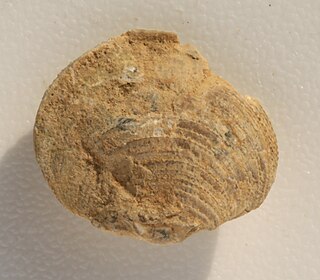 W
WCleiothyridina is an extinct genus of brachiopods.
 W
WComposita is an extinct brachiopod genus that lived from the Late Devonian to the Late Permian. Composita had a cosmopolitan global distribution, having lived on every continent except Antarctica. Composita had a smooth shell with a more or less distinct fold and sulcus and a round opening for the pedicle on the pedicle valve. Composita is included in the family Athyrididae and placed in the subfamily Spirigerellinae.
 W
WCrania is an extinct genus of brachiopods that lived during the Upper Cretaceous.
 W
WCyrtospirifer is an extinct genus of brachiopods. The fossils are present in the Middle and Upper Devonian.
 W
WDiscinisca is a genus of brachiopods with fossils dating back from the Early Devonian to the Pliocene of Africa, Europe, North America, and New Zealand.
 W
WGigantoproductus is a genus of extinct brachiopods in the order Productida and the family Monticuliferidae. The species were the largest of the carboniferous brachiopods, with the largest known species ranging in size from 9 to 12 centimeters. Productids date back to approximately 407 million years ago. As fossils, their shells occur within a limestone matrix.
 W
WGypospirifer is an extinct genus of articulate brachiopod fossils belonging to the family Trigonotretidae. They were stationary epifaunal suspension feeders.
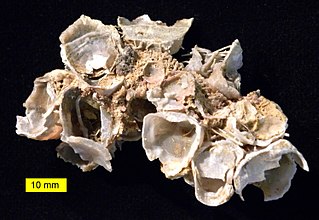 W
WHercosestria is an extinct genus of brachiopods from the Lower and Middle Permian. They were important reef-forming organisms because of their conical shapes, attaching spines, and gregarious habits. It is related to Richthofenia. Species of the genus have been found in Texas and Guatemala.
 W
WIsjuminella is a species of extinct, brachiopod, a marine rhynchonellate lampshell in the family Tetrarhynchiidae.
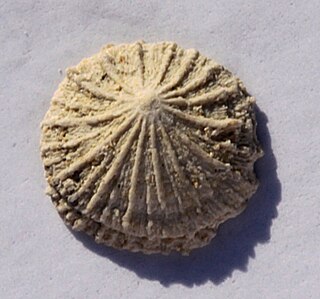 W
WIsocrania is an extinct genus of brachiopods found during the Upper Cretaceous. Early representatives were attached to the underground, but later species are presumed to be free living at an increasingly earlier age. This was probably an adaptation to the increasing very thick and fine sedimentation during the latest Cretaceous.
 W
WKallirhynchia is an extinct genus of brachiopods found in Jurassic strata in Europe, North Africa, the Middle East, India and Uzbekistan. It was a stationary epifaunal suspension feeder.
 W
WKingena is an extinct genus of primarily Cretaceous-aged brachiopods whose fossils are found in marine strata of Antarctica, Europe, North America, and New Zealand. Early Paleocene-aged fossils from Denmark represent the youngest species.
 W
WKutoringates are early rhynchonelliform brachiopods.
 W
WLeptaena is an extinct genus of mid-sized brachiopod that existes from the Dariwilian epoch to the Emsian epoch, though some specimens have been found in strata as late in age as the Tournasian epoch. Like some other Strophomenids, Lepteana were epifaunal, meaning they lived on top of the seafloor, not buried within it, and were suspension feeders.
 W
WLingulella is a genus of phosphatic-shelled brachiopod. It is known from the Middle Cambrian Burgess Shale (Canada) to the Upper Ordovician Bromide Formation in North America. 346 specimens of Lingulella are known from the Greater Phyllopod bed, where they comprise 0.66% of the community.
 W
WMeristella is an extinct genus of brachiopods found from the Late Silurian to the Late Devonian. They are characterized by a smooth oval shell and a prominent incurved beak on the pedicle valve. Meristella is placed in the family Meristellidae of the articulate brachiopod order Athyridida.
 W
WMicromitra is a genus of brachiopods known from the Middle Cambrian Burgess Shale. 160 specimens of Micromitra are known from the Greater Phyllopod bed, where they comprise 0.3% of the community.
 W
WMucrospirifer is a genus of extinct brachiopods in the class Rhynchonellata (Articulata) and the order Spiriferida. They are sometimes known as "butterfly shells". Like other brachiopods, they were filter feeders. These fossils occur mainly in Middle Devonian strata and appear to occur around the world, except in Australia and Antarctica.
 W
WNeospirifer is an extinct genus of articulate brachiopod fossils belonging to the family Trigonotretidae.
 W
WObolella is a genus of Cambrian brachiopods.
 W
WParaspirifer is a genus of large brachiopods that lived during the late Lower and Middle Devonian in what now are Germany, Spain, Morocco and the United States.
 W
WPentamerus is a prehistoric genus of brachiopods that lived from the Silurian to the Middle Devonian in Asia, Europe, and North America.
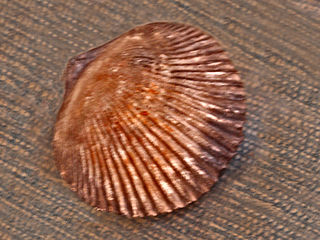 W
WPeregrinella is an extinct genus of brachiopods belonging to the family Peregrinellidae.
 W
WPlaesiomys is a genus of extinct lamp shells belonging to the family Plaesiomyidae.
 W
WPlatystrophia is an extinct genus of brachiopods that lived from the Ordovician to the Silurian in Asia, Europe, North America, and South America. It has a prominent sulcus and fold. It usually lived in marine lime mud and sands.
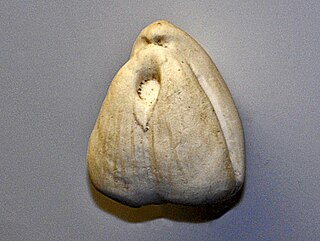 W
WPygope is an extinct genus of brachiopods belonging to the family Pygopidae. These brachiopods lived in open sea from the Jurassic Period, Kimmeridgian age up to Cretaceous Period, Barremian age. Some of the species are characterised by a smaller or larger perforation through the entire shell in older specimens, while others just have a depression somewhere on the midline. Younger specimens of the perforated species develop a heart-shape and subsequently both extensions merge, thus encircling a central passage which is in fact entirely outside the shell.
 W
WRafinesquina is an extinct genus of large brachiopod that existed from the Darriwilian to the Ludlow epoch.
 W
WRhaetina is an extinct genus of brachiopods belonging to the family Angustothyrididae.
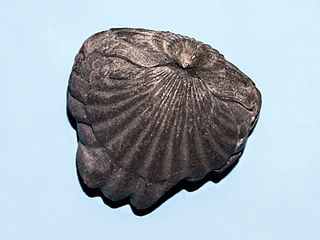 W
WRhynchonella is an extinct genus of brachiopod found in Silurian to Eocene strata worldwide. It was a stationary epifaunal suspension feeder.
 W
WSharpirhynchia sharpi is a species of extinct, small-sized lampshell, named after Samuel Sharp (1814–1882), an early fossil collector, who discovered the limited time span of some fossils, now known as index fossils. S. sharpi is a marine rhynchonellate brachiopod in the family Rhynchonellidae. It is roughly ½ inch (1.25 cm) measured along the axis, with a slender beak, the brachial valve more convex than the pedunculate valve, and it has 21–31 ribs fanning out from the hinge.
 W
WSomalirhynchia africana is a species of extinct, medium-sized brachiopod, a marine rhynchonellate lampshell in the family Tetrarhynchiidae. It is roughly the size and shape of a 1-inch (25 mm) toy marble, and has about 29 ribs fanning out from the hinge.
 W
WSphenorhynchia is an extinct genus of brachiopods belonging to the family Prionorhynchiidae.
 W
WSpirifer is a genus of marine brachiopods belonging to the order Spiriferida and family Spiriferidae. Species belonging to the genus lived from the Middle Ordovician (Sandbian) through to the Middle Triassic (Carnian) with a global distribution. They were stationary epifaunal suspension feeders.
 W
WSpiriferina is an extinct genus of brachiopods that lived from the Late Silurian to the Middle Jurassic in Asia, Europe, North America, South America, and New Zealand.
 W
WStringocephalus is an extinct genus of large brachiopods; between 388.1 to 376.1 million years old they are usually found as fossils in Devonian marine rocks. Several forms of the genus are known; they may be found in western North America, northern Europe, Asia and the Canning Basin of Western Australia. Several different types are known; they share a well-developed, curved structure shaped like a beak. Some of the largest specimens discovered to date have been found in China.
 W
WStrophomena is a genus of brachiopods belonging to the order Strophomenida family Strophomenidae, named by Rafinesque in 1824. They were stationary epifaunal suspension feeders.
 W
WTerebratula is a modern genus of brachiopods with a fossil record dating back to the Late Devonian. These brachiopods are stationary epifaunal suspension feeders and have a worldwide distribution.
 W
WUncites is an extinct genus of brachiopods in the family Uncitidae. This genus includes spire-bearing brachiopod with a rostrate ventral valve. A typical species is Uncites gryphus from the Middle Devonian in Germany.
 W
WVictorithyris is a genus of brachiopod from southern Australia. It lived during the Eocene to Miocene period.